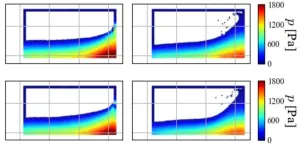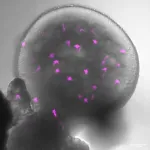(Press-News.org) By Shawn Ballard
Imagine a world where industrial waste isn’t just reduced, it’s turned into something useful. This kind of circular economy is already in the works for carbon. Now, researchers in energy, environmental & chemical engineering at Washington University in St. Louis have developed a promising pathway to convert harmful nitric oxide, a key component of acid rain, into valuable nitric acid, which is used in everyday applications from fertilizer production to metal processing.
Feng Jiao, the Lauren and Lee Fixel Distinguished Professor in the McKelvey School of Engineering at WashU, and collaborators developed a method to convert nitric oxide (NO) emissions into high-purity, concentrated nitric acid (HNO₃). The new process operates at near-ambient conditions with minimal infrastructure, offering an economically viable solution to industrial nitrogen waste with economic and environmental benefits. The work published April 3, in Nature Catalysis.
“We’ve developed an electrochemical approach to converting NO, a toxic waste gas, into valuable nitric acid,” Jiao said. “Our primary motivation is to address NO waste gases from mining sites, where large amounts of nitric acid are used to dissolve metal ores, leading to significant emissions. Our technology enables on-site NO conversion back into nitric acid for immediate reuse, creating a more sustainable and circular process.”
The innovative electrochemical process uses a low-cost carbon-based catalyst for NO oxidation. When combined with a single-metal oxygen reduction catalyst developed by Gang Wu, professor of energy, environmental & chemical engineering in McKelvey Engineering, the process operates with low energy consumption to convert NO into HNO₃ without the need for chemical additives or extra purification steps.
The electrochemical oxidation system is designed to be “plug and play,” Jiao says, constructed on-site without massive investments in infrastructure or expensive raw materials, such as precious metals. It is flexible and customizable for small- or medium-scale operations, and it works at near room temperature, significantly reducing energy use, cost and environmental impact compared with the most prevalent NO processing method that requires elevated operating temperatures.
The system achieves over 90% faradaic efficiency when using pure NO. Even at lower concentrations of NO, the system retains more than 70% faradaic efficiency, making it adaptable to a variety of industrial waste streams. The direct synthesis of concentrated high-purity HNO3 – up to 32% by weight – from NO and water without electrolyte additives or downstream purification establishes an electrochemical route to valorize NO waste gases, advancing sustainable pollution mitigation and chemical manufacturing.
Beyond mining, Jiao noted that the approach may have broader industrial applications as well as strong commercial potential, which Jiao and his collaborators demonstrated in a detailed techno-economic analysis that showed their process boasts lower energy consumption and reduced costs compared with traditional HNO₃ manufacturing methods. Turning industrial pollutants into valuable chemical products is just good business, as well as being good for the environment, Jiao said.
“The nitric acid output by our system can be directly used in mining applications or other chemical processes,” Jiao said. “We’ve already achieved very impressive efficiency and purity in our output. Going forward, we’ll be working to improve those numbers even further while also scaling up for practical applications. We’re looking at how we can build this technology into a nitrogen circular economy that will open doors to more efficient and sustainable agriculture, manufacturing and many other things.”
###
Xia R, Dronsfield S, Lee A, Crandall BS, Liang J, Hasa B, Redder A, Wu G, Goncalves TJ, Siahrostami S, Jiao F. Electrochemical oxidation of nitric oxide to concentrated nitric acid with carbon-based catalysts at near-ambient conditions. Nature Catalysis, online April 3, 2025. DOI: https://www.nature.com/articles/s41929-025-01315-8
This work was supported by Washington University in St. Louis, the University of Calgary’s Canada First Research Excellence Fund Program and the Global Research Initiative in Sustainable Low Carbon Unconventional Resources. It was also enabled in part by support provided by computational resources at the University of Calgary and Compute Canada
END
Electrochemical method supports nitrogen circular economy
New approach developed by Feng Jiao converts nitrogen waste into valuable chemical product
2025-04-03
ELSE PRESS RELEASES FROM THIS DATE:
How researchers are shining a light on kidney disease
2025-04-03
For patients with polycystic kidney disease (PKD), a common genetic disorder that ravages the waste-removing organ with cysts, dialysis and transplantation are among the only treatments.
More than 12.4 million people worldwide suffer from the dominant form of the condition. Now, Rutgers University geneticists have uncovered fresh details of how the disease progresses – findings that could open the door to new therapies.
In a study published in Nature Communications, Inna Nikonorova, a research assistant professor in the Department of Genetics within the Rutgers School of Arts and Sciences, reports on a novel way to identify and track material carried ...
Some gut bacteria could make certain drugs less effective
2025-04-03
A new study, published today in Nature Chemistry by researchers from the University of Pittsburgh and Yale University, shows how common gut bacteria can metabolize certain oral medications that target cellular receptors called GPCRs, potentially rendering these important drugs less effective.
Drugs that act on GPCRs, or G protein-coupled receptors, include more than 400 medications approved by the U.S. Food and Drug Administration (FDA) for treatment of many common conditions such as migraines, depression, type 2 diabetes, prostate cancer and more.
“Understanding how GPCR-targeted drugs interact with human gut microbiota is critical for advancing ...
PEPITEM sequence shows effects in psoriasis, comparable to steroid cream
2025-04-03
Birmingham scientists have shown that a sequence of just three amino acids may reduce the severity of psoriasis, when applied topically in an emollient cream.
The researchers, whose study is published in Pharmacological Research, identified the smallest part of a peptide (small protein) called PEPITEM, which occurs naturally in the body and regulates inflammation.
The study also showed that both PEPITEM and the three amino acid (tripeptide) sequence delivered a significant reduction in the severity of psoriasis, that is comparable to a steroid cream.
Psoriasis ...
Older teens who start vaping post-high school risk rapid progress to frequent use
2025-04-03
A new study has found that young vapers in the United States who begin using e-cigarettes after graduating from secondary/high school are likely to progress rapidly to frequent use. While US youths who start vaping during secondary/high school typically take about three years to progress to frequent use, this newly identified group of young adults who start vaping a bit later, after graduation (mean age = 20 years), tend to reach frequent use in about one year. ‘Frequent use’ is defined as using e-cigarettes on 20 or ...
Corpse flowers are threatened by spotty recordkeeping
2025-04-03
Commonly called the “corpse flower,” Amorphophallus titanum is endangered for many reasons, including habitat destruction, climate change and encroachment from invasive species.
Now, plant biologists from Northwestern University and the Chicago Botanic Garden have added a new threat to the list: incomplete historical records.
In a new study, scientists constructed the ancestry of corpse flowers living in collections at institutions and gardens around the world. They found a severe lack of consistent, standardized data. Without complete historical records, conservationists were unable to make informed decisions ...
Riding the AI wave toward rapid, precise ocean simulations
2025-04-03
AI has created a sea change in society; now, it is setting its sights on the sea itself.
Researchers at Osaka Metropolitan University have developed a machine learning-powered fluid simulation model that significantly reduces computation time without compromising accuracy. Their fast and precise technique opens up potential applications in offshore power generation, ship design and real-time ocean monitoring.
Accurately predicting fluid behavior is crucial for industries relying on wave and tidal energy, as well as for design of maritime structures and vessels. ...
Are lifetimes of big appliances really shrinking?
2025-04-03
Big appliances, like washing machines, ovens and refrigerators, are a major investment for many households. Consumers hope that these appliances will last for decades. More and more, however, people have the perception that these big-ticket items might not be lasting as long as they once did.
But when Kamila Krych looked at actual trends in product lifetimes as a part of her PhD research at the Norwegian University of Science and Technology's (NTNU) Industrial Ecology Programme, she found that wasn’t quite true.
“Despite what people think, there is no evidence that product lifetimes are decreasing,” she said. “Many people think that products have been becoming ...
Pink skies
2025-04-03
Organoids have revolutionized science and medicine, providing platforms for disease modeling, drug testing, and understanding developmental processes. While not exact replicas of human organs, they offer significant insights. The Siegert group at the Institute of Science and Technology Austria (ISTA) presents a new organoid model that reveals details of the developing nervous system’s response to viral infections, such as Rubella. This model could influence pharmaceutical testing, particularly benefiting drug safety for pregnant ...
Monkeys are world’s best yodellers - new research
2025-04-02
A new study has found that the world’s finest yodellers aren’t from Austria or Switzerland, but the rainforests of Latin America.
Published in the journal Philosophical Transactions of the Royal Society B and led by experts from Anglia Ruskin University (ARU) and the University of Vienna, the research provides significant new insights into the diverse vocal sounds of non-human primates, and reveals for the first time how certain calls are produced.
Apes and monkeys possess special anatomical structures in their throats called vocal membranes, which disappeared from humans through evolution to allow for more stable speech. However, ...
Key differences between visual- and memory-led Alzheimer’s discovered
2025-04-02
Differences in the distribution of certain proteins and markers in the brain may explain why some people first experience vision changes instead of memory loss in Alzheimer’s disease, finds a new study by UCL researchers.
Posterior cortical atrophy (PCA) is a rare form of Alzheimer’s disease that, rather than causing problems with memory, leads to difficulties with reading, navigating, and recognising objects. Studies suggest that one in 10 patients with Alzheimer’s disease have a form which is visual, rather than memory led.
As well as presenting with unusual symptoms, ...
LAST 30 PRESS RELEASES:
Scalable and healable gradient textiles for multi‑scenario radiative cooling via bicomponent blow spinning
Research shows informed traders never let a good climate crisis go to waste
Intelligent XGBoost framework enhances asphalt pavement skid resistance assessment
Dual-function biomaterials for postoperative osteosarcoma: Tumor suppression and bone regeneration
New framework reveals where transport emissions concentrate in Singapore
NTP-enhanced lattice oxygen activation in Ce-Co catalysts for low-temperature soot combustion
Synergistic interface engineering in Cu-Zn-Ce catalysts for efficient CO2 hydrogenation to methanol
COVID-19 leaves a lasting mark on the human brain
Scientists use ultrasound to soften and treat cancer tumors without damaging healthy tissue
Community swimming program for Black youth boosts skills, sense of belonging, study finds
Specific depressive symptoms in midlife linked to increased dementia risk
An ‘illuminating’ design sheds light on cholesterol
Who is more likely to get long COVID?
Study showcases resilience and rapid growth of “living rocks”
Naval Research Lab diver earns Office of Naval Research 2025 Sailor of the Year
New Mayo-led study establishes practical definition for rapidly progressive dementia
Fossil fuel industry’s “climate false solutions” reinforce its power and aggravate environmental injustice
Researchers reveal bias in a widely used measure of algorithm performance
Alcohol causes cancer. A study from IOCB Prague confirms damage to DNA and shows how cells defend against it
Hidden viruses in wastewater treatment may shape public health risks, study finds
Unlock the power of nature: how biomass can transform climate mitigation
Biochar reshapes hidden soil microbes that capture carbon dioxide in farmland
Reducing saturated fat intake shows mortality benefit, but only in high-risk individuals
Manta rays create mobile ecosystems, study finds
Study: Mixed results in using lipoic acid to treat progressive multiple sclerosis
Norbert Holtkamp appointed director of Fermi National Accelerator Laboratory
New agentic AI platform accelerates advanced optics design
Biologists discover neurons use physical signals — not electricity — to stabilize communication
Researchers discover that a hormone can access the brain by hitchhiking
University of Oklahoma researcher awarded funding to pursue AI-powered material design
[Press-News.org] Electrochemical method supports nitrogen circular economyNew approach developed by Feng Jiao converts nitrogen waste into valuable chemical product




